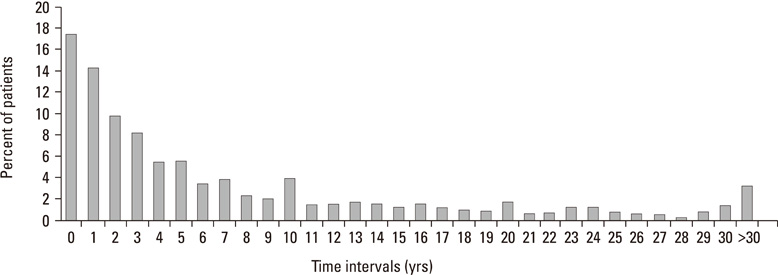Yonsei Med J.
2010 Jul;51(4):499-503. 10.3349/ymj.2010.51.4.499.
Gender Difference in Patients with Recurrent Neurally Mediated Syncope
- Affiliations
-
- 1Division of Cardiology, Department of Medicine, Samsung Medical Center, Sungkyunkwan University School of Medicine, Seoul, Korea. juneskim@skku.edu
- 2Pediatrics Cardiac and Vascular Center, Samsung Medical Center, Sungkyunkwan University School of Medicine, Seoul, Korea.
- 3Division of Cardiology, Gangneung Asan Hospital, University of Ulsan College of Medicine, Gangneung, Korea.
- 4Division of Cardiology, Department of Internal Medicine, Chungnam National University School of Medicine, Daejeon, Korea.
- KMID: 1805185
- DOI: http://doi.org/10.3349/ymj.2010.51.4.499
Abstract
- PURPOSE
The gender difference of neurally mediated syncope is not well defined in a large patient population. The aim of this study was to evaluate the gender difference of clinical manifestations in patients with neurally mediated syncope who underwent head-up tilt test.
MATERIALS AND METHODS
The medical records of 1,051 consecutive patients with two or more episodes of syncope, who were diagnosed as having neurally mediated syncope by head-up tilt test, were retrospectively reviewed.
RESULTS
Of 1,051 patients, 497 (47.3%) patients were male and 554 (52.7%) patients were female. Female patients were experiencing syncopal episodes for longer periods of their lives (8.2 +/- 9.5 years vs. 6.8 +/- 9.2 years, p = 0.002) and more episodes of syncope prior to head-up tilt test (HUT) (7.2 +/- 9.4 vs. 5.0 +/- 6.4, p = 0.001) than male patients. Micturition syncope (20.0% vs. 5.2%, p < 0.001) was observed more frequently in male patients than in female patients. To the contrary, however, defecation syncope (16.3% vs. 9.3%, p < 0.001) was observed more frequently in female patients than in male patients.
CONCLUSION
Female patients were experiencing syncopal episodes for longer periods of their lives and more episodes of syncope than male patients. Gender difference was also noted with regard to frequency of situational syncope.
Keyword
Figure
Cited by 1 articles
-
Retrospective analysis of risk factors of hypotensive bradycardic events during shoulder arthroscopic surgery under interscalene blockade in the sitting position
Taeha Ryu, Baek Jin Kim, Seong Jun Woo, So Young Lee, Jung A Lim, Sang Gyu Kwak, Woon Seok Roh
Korean J Anesthesiol. 2020;73(6):542-549. doi: 10.4097/kja.20035.
Reference
-
1. Soteriades ES, Evans JC, Larson MG, Chen MH, Chen L, Benjamin EJ, et al. Incidence and prognosis of syncope. N Engl J Med. 2002. 347:878–885.
Article2. Ganzeboom KS, Colman N, Reitsma JB, Shen WK, Wieling W. Prevalence and triggers of syncope in medical students. Am J Cardiol. 2003. 91:1006–1008.
Article3. Lipsitz LA, Wei JY, Rowe JW. Syncope in an elderly, institutionalised population: prevalence, incidence, and associated risk. Q J Med. 1985. 55:45–54.4. Savage DD, Corwin L, McGee DL, Kannel WB, Wolf PA. Epidemiologic features of isolated syncope: the Framingham Study. Stroke. 1985. 16:626–629.
Article5. Grubb BP. Pathophysiology and differential diagnosis of neurocardio-genic syncope. Am J Cardiol. 1999. 84:3Q–9Q.6. Kenny RA, Ingram A, Bayliss J, Sutton R. Head-up tilt: a useful test for investigating unexplained syncope. Lancet. 1986. 1:1352–1355.7. Colman N, Nahm K, van Dijk JG, Reitsma JB, Wieling W, Kaufmann H. Diagnostic value of history taking in reflex syncope. Clin Auton Res. 2004. 14:Suppl 1. 37–44.
Article8. Sheldon RS, Sheldon AG, Connolly SJ, Morillo CA, Klingenheben T, Krahn AD, et al. Age of first faint in patients with vasovagal syncope. J Cardiovasc Electrophysiol. 2006. 17:49–54.9. Natale A, Geiger MJ, Maglio C, Newby KH, Dhala A, Akhtar M, et al. Recurrence of neurocardiogenic syncope without pharmacologic interventions. Am J Cardiol. 1996. 77:1001–1003.
Article10. Barón-Esquivias G, Errázquin F, Pedrote A, Cayuela A, Gómez S, Aguilera A, et al. Long-term outcome of patients with vasovagal syncope. Am Heart J. 2004. 147:883–889.
Article11. Calkins H, Zipes DP. Libby P, Bonow RO, Mann DL, Zipes DP, Braunwald E, editors. Hypotesion and syncope. Braunwald's heart disease: a text book of cardiovascular medicine. 2007. 8th ed. Philadelphia (PA): W.B. Saunders;975–984.12. Kim PH, Ahn SJ, Kim JS. Frequency of arrhythmic events during head-up tilt testing in patients with suspected neurocardiogenic syncope or presyncope. Am J Cardiol. 2004. 94:1491–1495.
Article13. Brignole M, Menozzi C, Gianfranchi L, Oddone D, Lolli G, Bertulla A. Carotid sinus massage, eyeball compression, and head-up tilt test in patients with syncope of uncertain origin and in healthy control subjects. Am Heart J. 1991. 122:1644–1651.
Article14. Convertino VA. Gender differences in autonomic functions associated with blood pressure regulation. Am J Physiol. 1998. 275:R1909–R1920.15. Fu Q, Arbab-Zadeh A, Perhonen MA, Zhang R, Zuckerman JH, Levine BD. Hemodynamics of orthostatic intolerance: implications for gender differences. Am J Physiol Heart Circ Physiol. 2004. 286:H449–H457.
Article16. Frey MA, Hoffler GW. Association of sex and age with responses to lower-body negative pressure. J Appl Physiol. 1988. 65:1752–1756.
Article17. Minson CT, Halliwill JR, Young TM, Joyner MJ. Influence of menstrual cycle on sympathetic activity, baroreflex sensitivity, and vascular transduction in young women. Circulation. 2000. 101:862–868.18. Meendering JR, Torgrimson BN, Houghton BL, Halliwill JR, Minson CT. Menstrual cycle and sex affect hemodynamic responses to combined orthostatic and heat stress. Am J Physiol Heart Circ Physiol. 2005. 289:H631–H642.
Article19. Kapoor WN, Peterson JR, Karpf M. Micturition syncope. A reappraisal. JAMA. 1985. 253:796–798.
Article20. Pathy MS. Defeacation syncope. Age Ageing. 1978. 7:233–236.21. Kapoor WN, Peterson J, Karpf M. Defecation syncope. A symptom with multiple etiologies. Arch Intern Med. 1986. 146:2377–2379.
Article
- Full Text Links
- Actions
-
Cited
- CITED
-
- Close
- Share
- Similar articles
-
- Anesthesia-Related Neurally Mediated Syncope in the Perioperative Period: Two Case Reports
- The Clinical Characteristics and the Usefulness of the Ocular Compression Test in Syncope of Children Test
- Cardiac repolarization abnormalities and neurally mediated syncope: overlooked aspects in the diagnosis of pheochromocytoma
- Prevalence and Clinical Factors of Anxiety and Depression in Neurally Mediated and Unexplained Syncope
- Seizure-Like Activities during Head-Up Tilt Test-Induced Syncope



